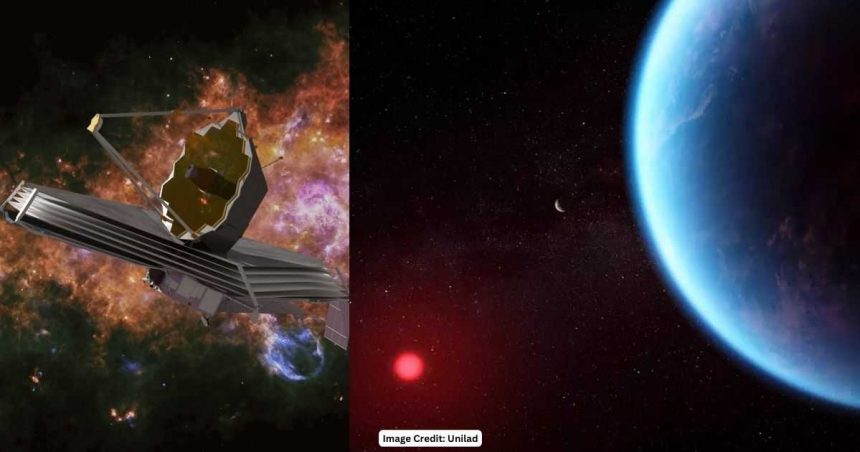The Role of JWST and NIRCam
The James Webb Space Telescope (JWST) represents a groundbreaking advancement in space observation technology, with tools specifically designed to study the universe with unprecedented clarity and depth. Among these tools, the Near-Infrared Camera (NIRCam) plays a crucial role, especially in the exploration of exoplanets like K2-18b.
Technological Aspects of JWST
The JWST is equipped with a suite of instruments that enable it to conduct a wide range of astronomical studies. Operating primarily in the infrared spectrum, it is essential for observing distant celestial objects whose light has been stretched into infrared wavelengths by the expansion of the universe. This capability is crucial for peering through cosmic dust and analyzing the chemical compositions of celestial bodies that are often hidden in visible light.
The telescope’s large 6.5-meter diameter primary mirror collects light from these distant objects, providing exceptional sensitivity to detect faint signals from far-off galaxies and exoplanetary systems. Made up of 18 hexagonal segments constructed from beryllium, known for its robustness and stability under extreme cold temperatures, the mirror design enhances the telescope’s ability to focus precisely on distant stars and their orbiting planets.
Role of NIRCam in Observing Exoplanets
As the primary imaging tool of JWST, NIRCam is essential in the quest for exoplanets. It conducts wide-field and deep-space imaging and photometry in the near-infrared range, crucial for detecting and analyzing exoplanet atmospheres. By observing the light passing through an exoplanet’s atmosphere during transit in front of its host star, scientists can infer the composition of the planet’s atmosphere, detecting elements and compounds like water vapor, methane, and complex organic molecules.
Additionally, NIRCam’s advanced optics help reduce the glare of stars, enhancing its ability to detect the faint lights of orbiting planets. This function is vital for accurately determining the atmospheric characteristics of exoplanets, offering insights into their potential to support life.
In conclusion, the JWST and NIRCam significantly enhance our ability to study distant exoplanets. These advanced tools provide detailed spectroscopic data and high-resolution imaging, allowing astronomers to explore exoplanet atmospheres and gain insights into their composition and conditions, potentially indicating the presence of life-supporting environments.
The Scientific Process and Future Steps
Humanity’s Quest for Extraterrestrial Life: Why Are We So Cosmic-Curious?
The intrigue behind discovering life beyond Earth stems from human curiosity and represents one of the most profound quests of our time. Recent investigations by the James Webb Space Telescope (JWST) into planets exhibiting potential ‘signs of life’ underscore this relentless pursuit. Several compelling reasons drive humanity’s eagerness to unearth extraterrestrial life:
Seeking Answers to Fundamental Questions: Uncovering life beyond Earth delves into fundamental queries about human existence, such as our solitude in the universe and the nature of life itself. Discovering life elsewhere could reshape our understanding of life’s essence.
Understanding Our Own Planet: Studying life beyond Earth provides critical insights into the evolution of life on our planet. By comparing Earthly life forms with potential extraterrestrial organisms, scientists can enhance their understanding of the conditions essential for life, benefiting biology, evolution, and environmental science.
Technological Advancement: The pursuit of extraterrestrial life fuels innovation and technological progress. Instruments like the JWST push the boundaries of technology and engineering, aiding in the search for life while driving advancements with practical applications on Earth.
Cultural and Philosophical Impact: Discovering extraterrestrial life holds significant cultural and philosophical implications. Such a revelation would challenge existing human perspectives on religion, philosophy, and life’s purpose, prompting a profound reassessment of our cosmic place.
Future Survival and Exploration: Understanding if life can thrive in environments different from Earth’s could be vital for humanity’s future survival and expansion. This knowledge might support colonizing other planets or utilizing extraterrestrial resources, enabling humans to become a multi-planetary species.
Uniting Humanity: The pursuit of extraterrestrial life is a global endeavor that transcends borders, cultures, and conflicts. It illustrates how a shared, global interest in exploring the cosmos can foster international cooperation, uniting diverse populations.
The efforts of the James Webb Space Telescope to investigate possible signs of life on distant planets not only satisfy our natural curiosity but also offer the potential to answer age-old questions about existence, promote international collaboration, and drive scientific and technological advancements. This pursuit connects us deeply with the mysteries of the universe, consistently reminding us of its vastness and our unique position within it.
Tips for Understanding Exoplanet Research
While exoplanet research may sound like science fiction, it is a real and captivating field uncovering worlds beyond our solar system. Here are some easy, relatable tips to help everyone comprehend and get excited about this fascinating topic:
Catch the Basics with Simple Analogies: Think of exoplanet detection as a cosmic game of hide and seek. When a planet passes in front of its star, it dims the star’s light, similar to hiding during play.
Get to Know the Neighborhood: The habitable zone often called the ‘Goldilocks zone,’ is where conditions are just right for water to exist in liquid form, akin to Goldilocks’ porridge choice!
Follow Along with Space Missions: Keeping up with missions like NASA’s James Webb Space Telescope is as easy as following space-themed social media pages or blogs for updates and engaging space photos.
Visuals are Your Friend: Explore images and videos from space agencies; these often come with explanations making exoplanet science more understandable.
Join the Conversation: Participate in community events or online forums discussing space science. You don’t need expertise to engage; curiosity is welcomed!
Use Everyday Resources: Numerous websites and YouTube channels simplify space topics in everyday language. Platforms like NASA’s YouTube channel or popular science channels demystify science with fun visuals and understandable commentary.
By applying these tips, you can follow and enjoy the ongoing journey of discovering new planets and potential signs of life beyond Earth. This adventure is for everyone, not just scientists, as we collectively delve deeper into the mysteries of the cosmos.
The Dawn of a New Era in Exoplanetary Science
The James Webb Space Telescope’s exploration of K2-18b symbolizes more than a technological milestone; it signifies an important leap in understanding the universe and our role within it. The insights from JWST offer a peek into the atmospheric conditions of a distant exoplanet, sparking the profound question of our cosmic companionship.
Continuously monitoring K2-18b and similar celestial bodies enriches our knowledge, refining our scientific methods and emphasizing that the quest for extraterrestrial life is as much about the journey as the destination. This ongoing exploration serves as a reminder of the universe’s enigmatic nature, prompting us to unravel more mysteries and inch closer to answering profound questions about life and existence. Looking ahead to the future of space exploration, the significance of public engagement and comprehension cannot be overstated. By simplifying the intricacies of space science, we invite more minds to ponder, question, and perhaps contribute to one of humanity’s greatest adventures.
.fbq(‘track’, ‘PageView’);






